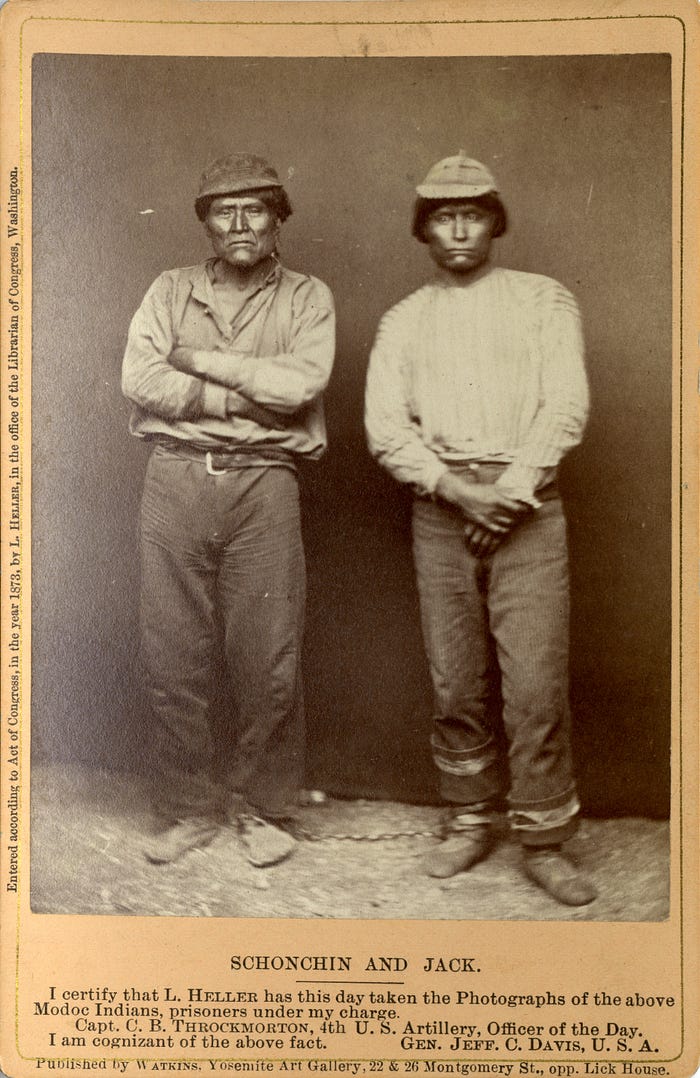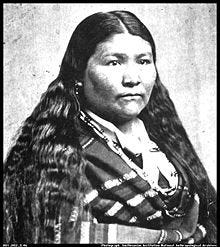Remembering the Modoc Warriors
Don Dexter stood at the base of the graves of the four young, Modoc warriors: Captain Jack, Black Jim, Schonchis, and Boston Charley, who were hanged for war crimes in front of their friends and family in 1873. The four wooden graves are hidden in the back of a large field in Fort Klamath, Oregon.
Dexter looked at the graves, with tears in his eyes, as he said, “there’s a lot of sadness because the graves don’t reflect what happened to these people and the tragedy of it.” These graves do not give justice to the Modoc warriors, according to Dexter, because “they are abandoned, and there isn’t anything to commemorate them.”

As a Modoc, Dexter does not want the story of his ancestors to be forgotten. In the form of a large rock, he intends to create a memorial to commemorate the Modoc War and the four warriors who were unjustly executed.
Dexter would like to choose a sizable rock from Medicine Lake — a place of significance where the Modoc people gathered medicine. Dexter believes a rock is important because it “represents strength, longevity, and it will be here forever.”
Dexter, a dentist based in Eugene, Oregon, is a Modoc Indian who is a direct descendent of Winema Toby-Riddle, a negotiator and translator during the Modoc War. Dexter's friend, Matt Smith, is a part of the Modoc, Klamath, and Shasta tribes and is a direct descendent of Captain Jack, a leader for the Modoc people during the war.

Both Dexter and Smith are grateful to have grown up listening to oral stories about the Modoc War. “I think that the oral stories are important because that’s our tradition and the stories need to keep being told to be kept alive,” said Smith. However, as they got older, they began to conduct their own research to learn more historical information about the war.
“The Modoc War was unfathomable,” said Smith. He believes that getting the story out will help people understand that “it’s not a fairytale, it’s not a cowboy-western movie, these were real people who had to suffer the consequences,” he adds.
In 1864 the U.S. government removed the Modoc tribe from their homeland in Northern California and forced them onto the Klamath reservation in southern Oregon. The Modoc tribe and the Klamath tribe had a history of tension. While on Klamath land, the Modoc people “were harassed and bullied by the Klamath Indians because they were guests on land that they weren’t welcome on,” says Dexter.
Given this situation, the Modoc people chose to leave the Klamath land. Captain Jack led a band of 160 Modoc people back to Northern California, their ancestral homelands, in 1872.
“Captain Jack, as their leader, had three choices: the first choice was to go along with the bullying and the harassment. The second choice was to fight back, but it wasn’t their land to stand up and fight. His third choice, which he did make, was to take his people and return to their ancestral homelands,” said Dexter.
As the Modoc band ventured south, they found safety among the Lava beds, large rock-formations on their ancestral lands in Northern California. Here is where much of the Modoc War took place.
During the war, Captain Jack was pressured to kill General E.R.S Canby, the military peace negotiator. The Modocs believed that if they killed Canby that the Modocs would win the war.
The killing of Canby marked the “point of no return” for the Modoc people. After this action, the Modoc people were captured and held as prisoners of war.
“I don’t agree with the Modocs that killing the peace negotiator was a good action, but when you’re in those situations there is no such thing as a good choice, it’s just a matter between a bad and a worse choice,” said Dexter.
“Standing here today by Canby’s cross is painful to think about what the Modoc people suffered going through this. But the fact that I’m here is evidence that the Modoc people have survived,” said Dexter.
The Modocs were then charged, tried, convicted, and executed for war crimes. This is the only incident in the history of Indian wars where this has happened.
On October 3rd, 1873, the four Modoc warriors were hanged by the U.S. Government at Fort Klamath for war crimes. Smith’s great-grandmother was there, and she passed down the stories about when they executed the four Modoc men. “She said that the women were just wailing and weeping,” said Smith. “I can’t even imagine having to endure that. Traumatic doesn’t even begin to explain it.”
After the four men were brutally executed, their bodies were buried on site and their heads were cut off and then sent to a military museum in Maryland. “God, it’s just unthinkable! It’s barbaric,” said Smith.
A majority of the remaining Modocs were held captive and forced to relocate to a reservation in the northeast corner of Oklahoma.
Smith believes that the memorial at the graves is important for him and his people to have acknowledgment and closure. “I think the biggest thing is getting the word out there to ‘never forget,’” said Smith. “This is like our ‘twin towers,’ and we will never forget what was done to us.”
A rock is a traditional and honorable way for Modoc people to mark the graves of their ancestors. According to Smith, the current graves are fragile and poorly maintained. Smith believes that a large rock is going to “be something really solid and keep the story alive for a long time as opposed to a piece of wood that will deteriorate and blow away.”
Dexter hopes to choose a rock from Medicine Lake. The purpose of this rock is to share the medicine with their people. The size of the rock will be substantial and it will contrast the plains landscape of Fort Klamath. Dexter wants to place a marker on this rock that tells who the people were. “We can’t return these men to their lands but we can maybe bring some of the land here,” said Dexter.

Dexter intends to hold a memorial for the Modoc War at Fort Klamath on October 3rd, 2021. This date is the same day that the Modoc men were executed in 1873.
“The hard thing for me about generational trauma is that a lot of people don’t even know what the trauma was. We have to understand it to try and heal,” said Dexter. “One of the reasons I feel we need to have more of a memorial here is to not erase the history, but to teach history. With teaching, hopefully, we can get some healing and recovery… some.”
If you would like to donate to the future Modoc War Memorial Documentary, here is a link to the Go Fund Me.
